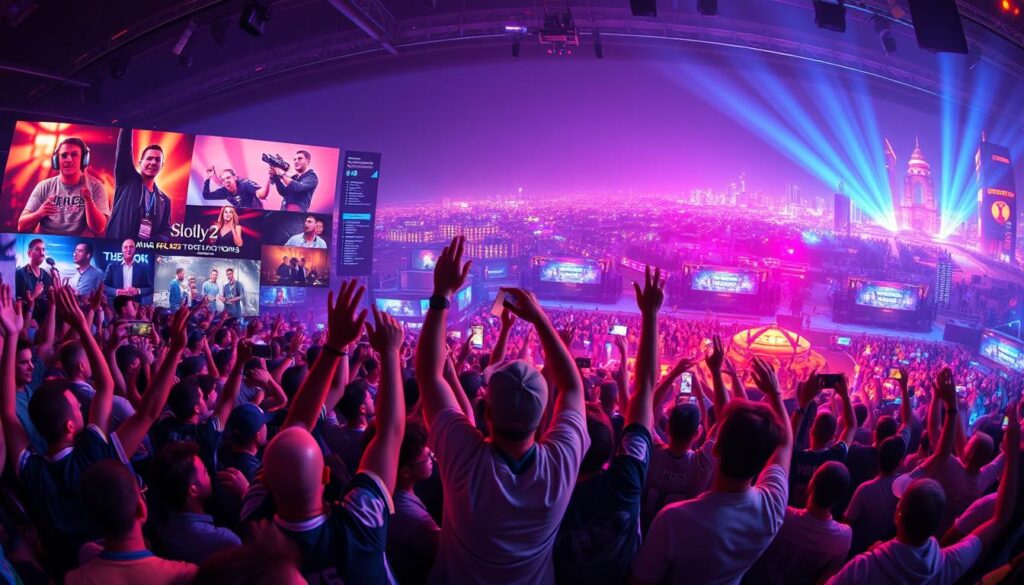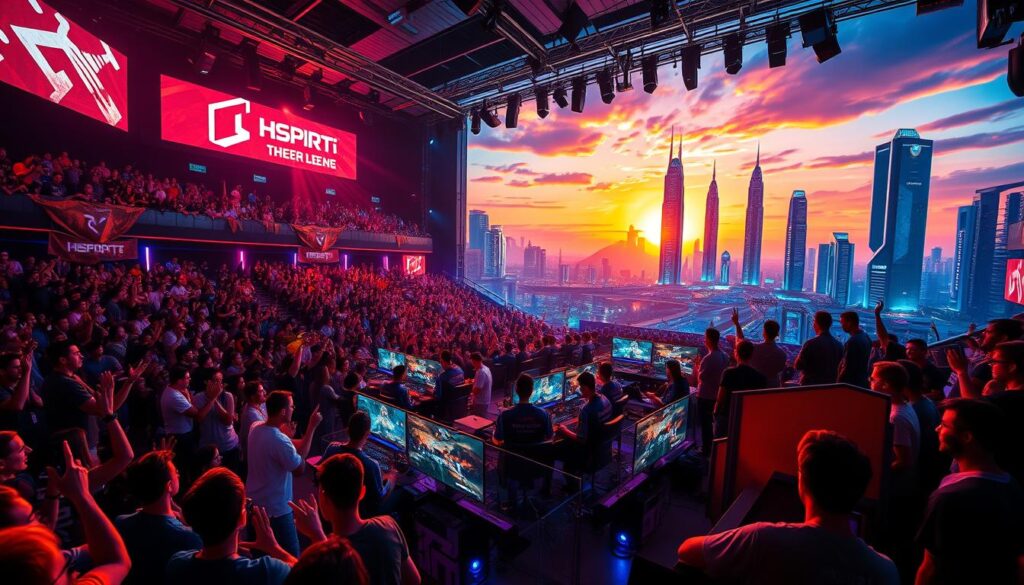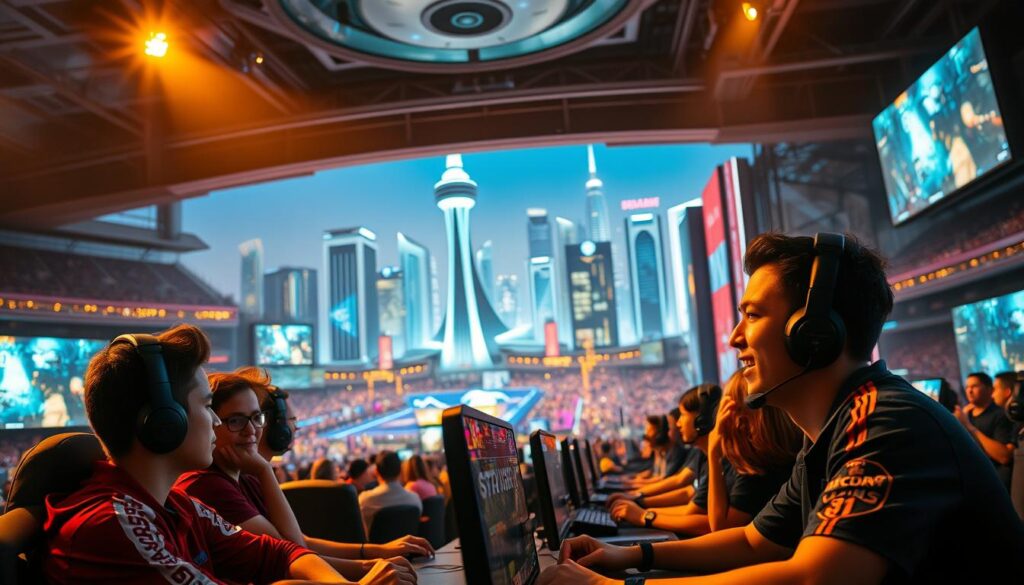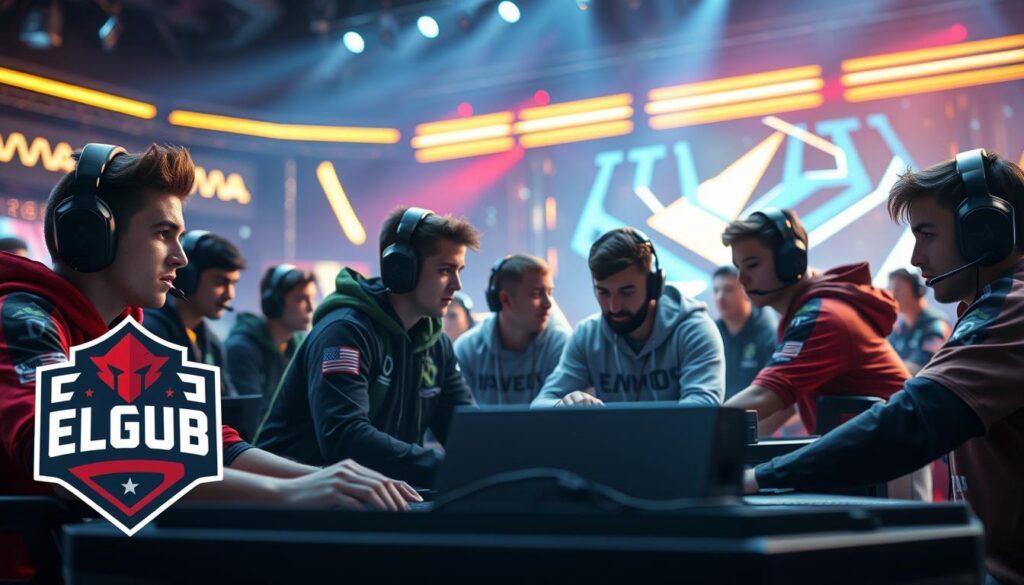Imagine a mix of Wimbledon-level strategy and NASCAR-worthy reflexes on screens. That’s what competitive gaming is today. It’s a big change from playing games in basements as kids.
Remember when “LAN party” meant a few friends sharing a dial-up connection? Now, esports is a $1.8B industry with stadium events that rival the Olympics.
Esports isn’t just about quick reflexes. It’s like digital chess, where players make precise moves while staying focused for hours. Why do 234 million people watch? They admire the strategy and skill, just like in sports.
This world turns button-mashing kids into pros who analyze every move. Your cousin’s Fortnite sessions? They’re learning about resource management and physics. These skills can even get them sponsorships worth more than your retirement savings.
As arenas fill with cheering fans, we’re seeing the start of sports 2.0. It’s all about the excitement, without the grass stains.
Introduction: Defining Esports
What makes esports different from just playing games late at night? Imagine 20,000 fans cheering as a 17-year-old from Seoul beats a Brazilian rival at 300 actions per minute. It’s not just gaming—it’s gladiatorial combat with RGB lighting. In 2022, Merriam-Webster defined esports as “organized competitive gaming,” but that’s like calling the Super Bowl “people throwing a ball.”
Here’s the secret sauce: structure. While casual gaming is like watching Netflix, esports is like a Fortune 500 company. Teams have:
- Nutritionists optimizing players’ reaction times
- Data analysts tracking mouse movement patterns
- Psychologists managing pre-finals jitters
The numbers don’t lie. Top players earn seven figures—not from Twitch donations, but through sponsorships as complex as F1 racing deals. When Riot Games’ League of Legends became an Asian Games medal event, it became a mainstream spectacle.
“Esports combines the reflexes of boxing with the strategy of chess—if chess had $30 million prize pools and sneaker endorsements.”
Casual gaming is like your basement LAN party. Esports? It’s the digital colosseum where milliseconds decide careers. The real question isn’t “What is esports?” but “Why hasn’t ESPN replaced baseball with Dota 2 highlights yet?”
Brief History of Esports
What do Nixon-era computer labs, arcade token wars, and a Ferrari have in common? They’re all key moments in esports history. This journey started in 1972 with Spacewar! battles in Stanford labs. The prize? A year’s subscription to Rolling Stone.

The 80s brought intense arcade rivalries, like in WarGames. High scores were more than bragging rights; they were physical leaderboards. Teenagers etched their initials on Pac-Man machines, the first gamer tags.
In 1997, id Software offered a Ferrari to the winner of Red Annihilation. The winner’s reaction? Imagine dial-up modem screeches mixed with joy.
Broadband internet changed everything. LAN parties in basements led to professional leagues fast. By 2023, League of Legends filled Seoul’s 45,000-seat arena. The 1972 Spacewar! had 20 participants. Last year’s Dota 2 International had 18 million viewers.
“We weren’t athletes – we were kids who forgot to eat because we were too busy beating high scores.”
Let’s look at the big changes:
- 1972-1990: Academic experiments → Arcade culture
- 1997-2005: Carmack’s Ferrari → Online multiplayer dawn
- 2010-Present: Twitch streams → Global franchises
This isn’t just gaming history. It’s how play became profession. From Rolling Stone subscriptions to $10M prize pools, every gamer helped build this giant. Next time someone says “video games aren’t real sports,” tell them: the kid who won that Ferrari drives it to their esports hall of fame.
Key Moments in Esports Evolution
Let’s talk about the moments that made competitive gaming feel less like a basement hobby and more like Madison Square Garden. You know that split-second in sports where time freezes? For basketball, it’s Jordan’s “Flu Game.” For esports? Look no further than EVO 2004’s Daigo Umehara parrying Justin Wong’s Chun-Li super attack frame by frame while at 1 HP. This wasn’t just gameplay – it was digital performance art. Crowds lost their minds. YouTube clips went viral before “viral” was even a marketing strategy. Suddenly, everyone realized: This was sport.
Then came Twitch in 2011. Think of it as competitive gaming’s equivalent of MTV – a platform that turned button-mashing into must-watch drama. Overnight, players became influencers. Matches became spectacles. And your average gamer? They went from “mom’s basement” stereotypes to legitimate entertainers pulling bigger audiences than cable news. The line between athlete and content creator? Obliterated.
“The NBA 2K League draft wasn’t just players getting picked – it was the moment virtual athletics demanded real-world respect.”
Fast-forward to 2017. The NBA 2K League draft made history by blending physical and virtual sports in ways even sci-fi writers hadn’t predicted. Teams like the Mavericks and Lakers started recruiting gamers with the same scrutiny they’d use for rookie prospects. Salaries? Contracts? Health benefits? Suddenly, pro gaming careers had blueprints beyond tournament winnings.
But let’s not forget the money move that changed everything. When Valve’s 2013 Dota 2 compendium crowdfunded a $2.8M prize pool, it wasn’t just about cash – it was a cultural mic drop. Fans weren’t just spectators anymore; they were investors. This wasn’t corporate sponsorship. This was the crowd yelling: “Take our money and make this sport legit.”
- EVO 2004: Competitive gaming’s “I’m walking here!” moment
- Twitch (2011): Where gameplay met prime-time
- NBA 2K League Draft (2017): Virtual meets vertical leap
- TI3 Compendium (2013): Crowdfunding the esports revolution
These milestones didn’t just shape careers – they built an entire industry’s playbook. Want to go pro today? You’re not just grinding ranked matches. You’re studying Daigo’s nerves of steel, mastering Twitch charisma, and maybe even practicing your draft combine interview. Game on.
The Global Esports Industry Today
2023 is like the boss level of esports – it’s complex, lucrative, and super competitive. The industry is like a digital Russian nesting doll. Game publishers are the puppet masters, teams like FaZe Clan are listed on Nasdaq, and NBA teams are trying to get in on the action. But there’s more to it than just the flashy streams on Twitch.
Behind the scenes, the esports industry is a $1.8 billion machine (Statista). It’s fueled by three main ways to make money:
| Revenue Stream | Market Share | Poster Child | Reality Check |
|---|---|---|---|
| Sponsorships | 73% | T1’s $210M Samsung deal | Brands want Gen Z eyeballs, not profit margins |
| Media Rights | 11% | YouTube’s $160M Overwatch deal | Platforms betting on live content supremacy |
| Merchandise | 9% | 100 Thieves streetwear drops | Limited-run hype meets inventory headaches |
The rush for sponsorships is huge – T1’s deal is worth more than some NFL teams. But, 43% of esports teams aren’t making money, even with 8.7% growth each year.
“We’re building Formula 1 teams while figuring out engines,” says an anonymous team CFO. “But try telling that to venture capitalists.”
This creates interesting career choices. Want stability? Be a sponsorship expert. Want to be creative? Make content for TikTok fans. The esports industry has many roles, from data analysts to lawyers.
But, there’s a big question: will the industry get smaller? When sports teams buy esports teams, is it a sign of growth or trouble? It depends on whether you’re in it for the money or the game.
Major Esports Titles and Genes
Imagine picking the Avengers while figuring out artillery plans. That’s esports strategy today. It’s a world where 20-million player battlegrounds meet super-focused tactical games. Let’s look at the big names in competitive gaming:
Dota 2 is like quantum chess, with 124 heroes and 30+ abilities each. This creates endless team setups. On the other hand, CS:GO is like Navy SEAL training, with $3 million tournaments depending on quick reactions and smart use of smoke grenades.
Riot Games’ big games show two different ways to play:
| Title | Active Players | Key Mechanic | Meta Cycle |
|---|---|---|---|
| League of Legends | 150M monthly | Champion bans | 3-week patches |
| Valorant | 22M monthly | Agent abilities | 2-month acts |
Valorant’s agent meta is like putting together Ocean’s Eleven. Each agent’s ultimate is like a special heist tool. Overwatch, on the other hand, has a role queue system that makes team play more like a symphony.
Why do League’s Worlds get more viewers than the NBA Finals? It’s because of:
- 15 years of building up a story (faker = MJ with better APM)
- Regional pride (LCS vs LCK vs LPL)
- Patch notes that change the game like Fed interest rates
Battle royales face a big question – can 100-player games really be fair? Fortnite tries to answer with huge prize pools and crazy zero-build modes. Apex Legends goes for hero-shooter hybrids and cool movement tech.
Pro tip: Watch Riot’s balance changes like Wall Street watches CPI reports. When they nerf Jett’s dash in Valorant, it’s like raising interest rates on entry fraggers.
Structure of Modern Esports
Exploring modern esports leagues is like trying to conquer Elden Ring blindfolded. It’s full of layers. At the top, you have leagues like the Call of Duty League, where teams spend $25 million to compete. Below that, semi-pro circuits help players grow, while grassroots tournaments are like hidden gems.

| Tier | Examples | Investment | Player Path |
|---|---|---|---|
| Franchise Leagues | Overwatch League, CDL | $20M+ buy-ins | Pro contracts + sponsorships |
| Semi-Pro Circuits | VALORANT Challengers | Org-funded salaries | Scouting opportunities |
| Grassroots | Local LAN events | Prize pools | Prove ground for amateurs |
Teams like Team Liquid are like Marvel superheroes. They’re athletes and content creators all in one. Their players stream for hours, keeping their skills sharp. South Korea’s LCK is the blueprint for success, with top-notch training facilities and mental health support.
For those aiming to be pros, learn from Faker. The T1 legend didn’t just master Zed – he became a League of Legends icon. His $6M/year deal shows success in esports needs skill, branding, and avoiding burnout.
The career path is clear:
- Grind ranked matches → Join amateur team
- Dominate regional events → Get scouted
- Survive academy leagues → Franchise draft
In modern esports, your Twitch followers are as important as your game skills. Players who succeed can take down opponents and build their brand at the same time.
Conclusion
The controller-clicking revolution has grown beyond basement LAN parties. In 1972, Stanford students played Spacewar! in tournaments. No one thought we’d see college scholarships for Street Fighter combos or Olympic Rocket League streams.
Today, we watch South Korean StarCraft pros become national heroes. EA Sports even wants esports in the Commonwealth Games. It’s a big change.
Traditional sports are facing a big challenge. The Olympic Virtual Series 2023 drew more viewers than some track heats. This shows digital sports are here to stay.
Major League Baseball teams are investing in MLB: The Show leagues. Formula 1’s Virtual Grand Prix series kept fans engaged during lockdowns. It’s not just about replacing traditional sports, but working together.
There are challenges, like player burnout and tricky monetization. But, universities like Ohio State are building esports arenas. Riyadh is funding $500M gaming hubs. The future looks bright.
The question is, which traditional sports will adapt first? Will the Yankees buy a League of Legends LEC slot before the Lakers draft a Fortnite star? It’s an exciting time.




